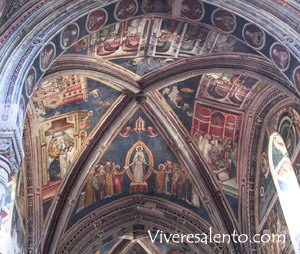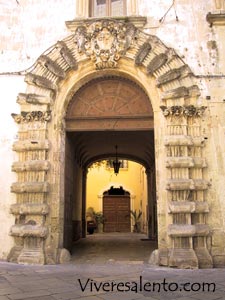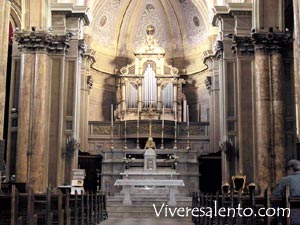|
|

Three old doors used to protect the village in the old times:
Capuchins’ Door (19th century), St Peter’s Door and Door of the Light date both
to the 19th century. In the historic centre the tourist can visit several ‘case
a corte’ and palaces such as Tafuri Palace, Zimarra Palace, Berardelli Palace,
Orsini Palace, Mangiò Palace
 and
so on. The Church of St Catherine of Alexandra was built in 1383, on the façade
there is a central portal richly decorated and other two smaller side portals.
The church has nave and double aisles. The internal walls are thoroughly covered
with frescos. The painting of the Martyrdom of St Agate and that of Our Lady of
the Apple are both valuable works. The Parish Church is dedicated to St Peter,
has a nave and two aisles. It was built in 1335, restored after the earthquake
of 1473 and the baroque altars were demolished in 1875 and rebuilt. Its stately
façade has three portals dating to the 17th century. Inside we can admire the
paintings representing the Assumption of St Joseph, The Rosary and Our Lady of
the Carmine. The Church of the Carmine was built together with the Monastery of
the Carmelite between 1670 and 1974. In 1809 the Carmelites left the monastery,
which became a Hospital. It is an aisleless church, there is a 18th century
organ, some altars and a painting representing Our Lady with the Child. The
Church of St Mary of the Graces was built in 1508 next to the Dominican
Monastery according to the will of the Castriota Scanderbegs but it was
thoroughly restructured in 1720. It has a stately portal and a Latin cross plan.
Inside there is a 18th century organ and eight altars richly decorated. The
Church of Our Lady of the Sorrow is an aisleless church and dates to the 18th
century. Its and
so on. The Church of St Catherine of Alexandra was built in 1383, on the façade
there is a central portal richly decorated and other two smaller side portals.
The church has nave and double aisles. The internal walls are thoroughly covered
with frescos. The painting of the Martyrdom of St Agate and that of Our Lady of
the Apple are both valuable works. The Parish Church is dedicated to St Peter,
has a nave and two aisles. It was built in 1335, restored after the earthquake
of 1473 and the baroque altars were demolished in 1875 and rebuilt. Its stately
façade has three portals dating to the 17th century. Inside we can admire the
paintings representing the Assumption of St Joseph, The Rosary and Our Lady of
the Carmine. The Church of the Carmine was built together with the Monastery of
the Carmelite between 1670 and 1974. In 1809 the Carmelites left the monastery,
which became a Hospital. It is an aisleless church, there is a 18th century
organ, some altars and a painting representing Our Lady with the Child. The
Church of St Mary of the Graces was built in 1508 next to the Dominican
Monastery according to the will of the Castriota Scanderbegs but it was
thoroughly restructured in 1720. It has a stately portal and a Latin cross plan.
Inside there is a 18th century organ and eight altars richly decorated. The
Church of Our Lady of the Sorrow is an aisleless church and dates to the 18th
century. Its façade has two small portals and is very sober. In the middle of the portal
there is a statue of the Virgin made in 1716. Inside there are fourteen
paintings dating to 1756 and six pictures of 1780, the most important is the
painting with the Pity. The tourist should also visit the Church of the Leaves.
Above the portal there is a statue of the Virgin whose mantle is hold by two
angels. Inside there are three altars, a pipe organ and interesting paintings
representing the Nativity, the Magi and the Virgin. The Church of St Catherine
was built in 1506 by the Olivetans and was restructured at the beginning of the
17th century. At first the church had a nave and two aisles, but now is
aisleless and its façade is very sober. The Church of St Mary of the Light was
built in the 17th century according to the will of the Bishop Santander and the
valuable painting of the Rosary dates to the same century. The church and the
Monastery of the Capuchins were built in the 16th century according to the will
of Nicola Zimarra who sold everything he had to help paying out the building.
Inside the church there are six altars but the organ was destroyed in the Second
World War. In 1866 the Capuchins left the monastery and it became barracks. The
small Church of the Virgin of the Purity was built in the 17th century. Inside
the church there are a wooden statue of the Virgin and a painting which shows
Jesus giving the keys to St Peter. The church of the Souls in Purgatory was
finished in 1708 and has an octagonal plan. The façade is very sober. The high
altar is dedicated to the Virgin of Loreto made in our local stone and, above
it, there is a stately painting representing the Virgin and the Souls of the
Purgatory. In the territory of Galatina, outside the urban area, the tourist
should also visit the farms (masserie), such as Masseria Li Vasci, Masserie Case
Russe, Masseria Lo Scalfo, Masseria La Grotta and so on. The patron saints of
the village are St Peter and Paul and the population celebrates them on June
29th.
façade has two small portals and is very sober. In the middle of the portal
there is a statue of the Virgin made in 1716. Inside there are fourteen
paintings dating to 1756 and six pictures of 1780, the most important is the
painting with the Pity. The tourist should also visit the Church of the Leaves.
Above the portal there is a statue of the Virgin whose mantle is hold by two
angels. Inside there are three altars, a pipe organ and interesting paintings
representing the Nativity, the Magi and the Virgin. The Church of St Catherine
was built in 1506 by the Olivetans and was restructured at the beginning of the
17th century. At first the church had a nave and two aisles, but now is
aisleless and its façade is very sober. The Church of St Mary of the Light was
built in the 17th century according to the will of the Bishop Santander and the
valuable painting of the Rosary dates to the same century. The church and the
Monastery of the Capuchins were built in the 16th century according to the will
of Nicola Zimarra who sold everything he had to help paying out the building.
Inside the church there are six altars but the organ was destroyed in the Second
World War. In 1866 the Capuchins left the monastery and it became barracks. The
small Church of the Virgin of the Purity was built in the 17th century. Inside
the church there are a wooden statue of the Virgin and a painting which shows
Jesus giving the keys to St Peter. The church of the Souls in Purgatory was
finished in 1708 and has an octagonal plan. The façade is very sober. The high
altar is dedicated to the Virgin of Loreto made in our local stone and, above
it, there is a stately painting representing the Virgin and the Souls of the
Purgatory. In the territory of Galatina, outside the urban area, the tourist
should also visit the farms (masserie), such as Masseria Li Vasci, Masserie Case
Russe, Masseria Lo Scalfo, Masseria La Grotta and so on. The patron saints of
the village are St Peter and Paul and the population celebrates them on June
29th.

The people living in Galatina are usually called ‘carzi
larghi’ or ‘cuccasci’. ‘Carzi larghi’ means large trousers
 and
is an idiomatic expression to mean they are boast and vain people. ‘Cuccasci’
means ‘owl’ and apparently they are a bit naïve and silly. This animal is one of
the characters of an old legend. Once upon a time a farmer sat down and looked
at the wheat he had just finished harvesting. He was proud of himself and very
satisfied with the outcome, suddenly he heard somebody screaming ‘ that all
mine’ (the Italian words sound like the cry of an owl), but he could not see
anybody around him. The bird went on making its strange sounds, the farmer went
on hearing the same sentence and he did not realize it was only an owl cry! The
farmer thought an impertinent and shrewd person was hiding somewhere, he was
more and more frightened so, at the end, he decided to burn his own harvest
instead of leaving it to somebody else. He burnt what he had tilled for such a
long time! and
is an idiomatic expression to mean they are boast and vain people. ‘Cuccasci’
means ‘owl’ and apparently they are a bit naïve and silly. This animal is one of
the characters of an old legend. Once upon a time a farmer sat down and looked
at the wheat he had just finished harvesting. He was proud of himself and very
satisfied with the outcome, suddenly he heard somebody screaming ‘ that all
mine’ (the Italian words sound like the cry of an owl), but he could not see
anybody around him. The bird went on making its strange sounds, the farmer went
on hearing the same sentence and he did not realize it was only an owl cry! The
farmer thought an impertinent and shrewd person was hiding somewhere, he was
more and more frightened so, at the end, he decided to burn his own harvest
instead of leaving it to somebody else. He burnt what he had tilled for such a
long time!
|